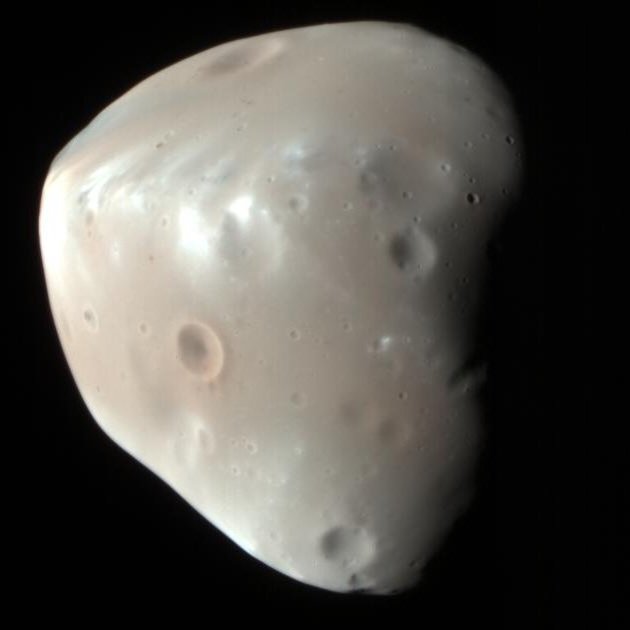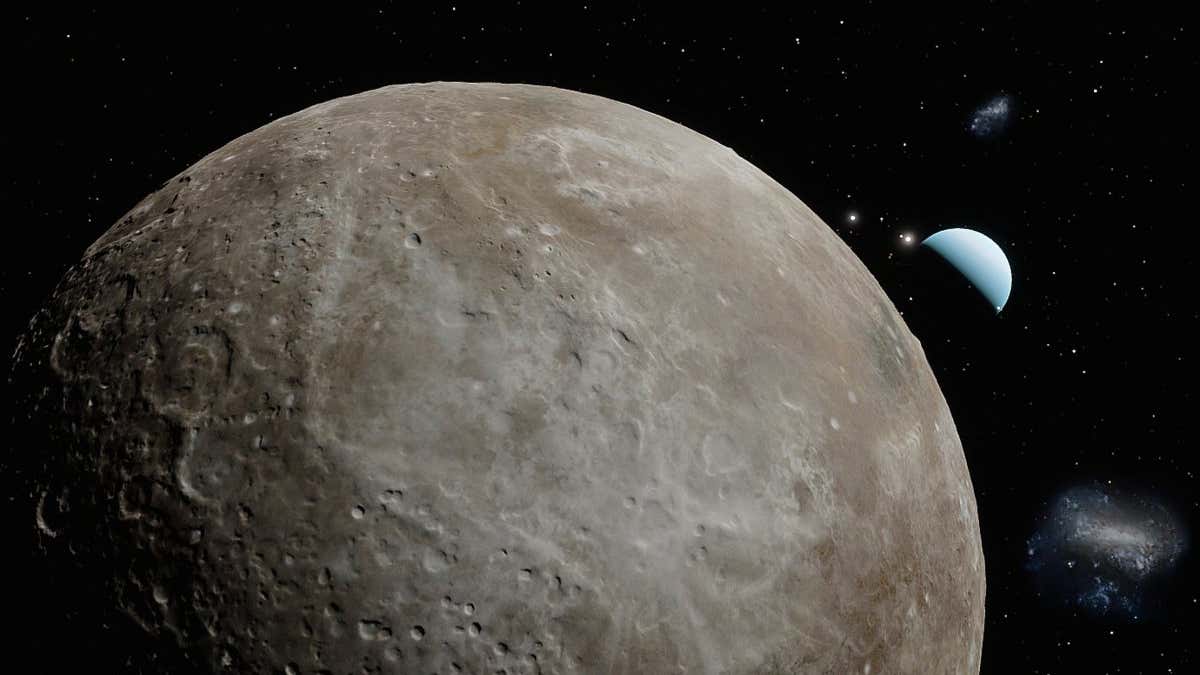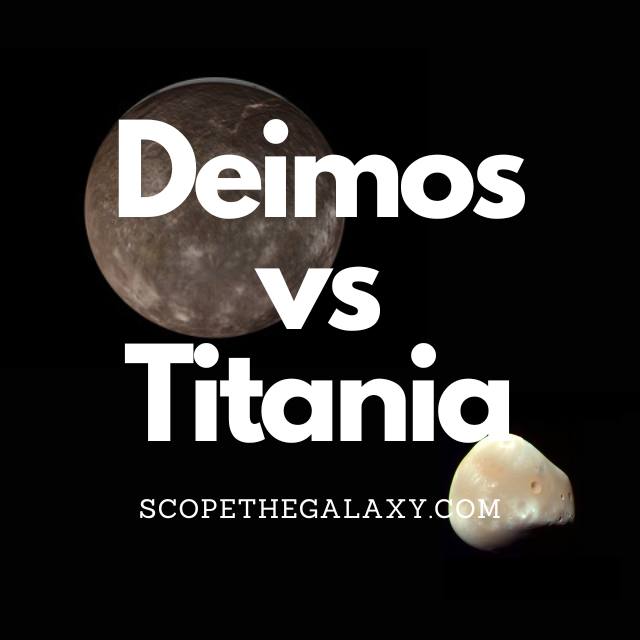*This post may contain affiliate links. This means we may make a commission if you purchase an item using one of our links*
The main differences between Deimos and Titania are that Deimos is a moon that orbits Mars while Titania is a moon that orbits Uranus, Titania is bigger with a diameter 1576.8km compared to Deimos’ diameter of 12.4km and Titania is spherical in shape while Deimos is not.
There are various other differences between the two so, continue reading if you want a more detailed look at both of these bodies along with their similarities and differences below.
What Is The Moon Deimos?
Table of Contents

Deimos is the smaller and outermost of the two moons of Mars, named after the Greek God of dread and terror (the brother of Phobos). This satellite was also discovered by American astronomer Asaph Hall just five days before Phobos (12th August 1877).
Scientists like Johannes Kepler had put forward theories for the existence of these moons many years before they were discovered. Their calculations were based on the fact that the planets on either side (Earth and Jupiter) possessed one and four moons, respectively.
Still, none were discovered until the 19th century. One of the main reasons for this is that the tiny size of Phobos and Deimos, combined with an exceptionally close orbit to their planet, means that the glare of Mars often obscures our view of them.
Phobos measures just 15 x 12 x 11 km and completes an orbit of Mars once every 30 hours.
This tiny moon is also a heavily cratered landscape shaped by the impact of asteroid collisions over time. However, the material thrown up from these impacts doesn’t appear to have landed back on the moon’s surface as it usually would. This could be because the lack of gravity on Phobos allowed the ejected material into space.
The surface gravity on Deimos is just 0.003 m/s^2 (compared to 9.807 m/s^2 on Earth), which means the average gravitational pull of Deimos is only 0.003 m/s. With only 1/2500th of Earth’s gravity, you would need a tether to walk on this rocky moon, or every step would put you at risk of achieving escape velocity and launching yourself into space.
The composition of Deimos is similar to Phobos, suggesting that it might also be a captured asteroid. Its surface is very dark gray and has an albedo of around 0.07, meaning it reflects just 7% light (about half of the light Earth’s moon can reflect).
What Is The Planet Titania?

Titania is the biggest of Uranus’s moons, with a circumference of 4,956km and a diameter of 1576.8km.
The high density of this moon suggests that it most likely formed from a collection of dust and debris leftover from the formation of Uranus or from the debris created in the collision that reportedly tilted Uranus onto its side. As a result Titania has a mass of 3.4 × 10^21 kg.
First discovered on 11th January 1787 (the same day as the discovery of Oberon, the second biggest moon of Uranus) by British astronomer William Herschel, the name “Titania” comes from the Shakespeare play, A Midsummer Night’s Dream. (Most of Uranus’ moons are named after Shakespeare’s characters.)
Having observed Titania for many years, scientists theorize that its composition is likely to be equal parts ice and rock, the latter of which may contain carbonaceous materials and organic compounds.
Research suggests that the moon most likely has a rocky core (accounting for 66% of the moon’s radius) and an icy mantle. If the mantle contains ammonia, it will act as antifreeze and make it possible for liquid water to exist. In this instance, the moon could possess a layer of liquid ocean around 50km thick.
Titania tilts slightly towards the equator of Uranus and is tidally locked to its planet. This means a Titania day is 8 days and 17 hours which would be the same for its orbital cycle.Titania has an average temperature of -203 degrees Celsius.
The planet Uranus is also tilted, with the moons orbiting on the equatorial plane, giving it extreme seasons. On Titania, the north and south poles experience 42 years of complete sunshine followed by 42 years of total darkness.
Scientists have observed the presence of large amounts of carbon dioxide, suggesting this may be the primary component of this moon’s atmosphere. Thanks to the tilted orbit, and a concentration of solar radiation from the poles, Titania probably maintains a carbon dioxide cycle, similar to the hydrogen cycle on Earth.
Similarities Between Deimos And Titania
As both are natural satellites, Phobos and Titania do share a few similarities, which includes the following:
- Both have a rocky, terrestrial surface.
- Neither have rings surrounding them.
- Both are tidally locked to their planet.
- Both orbit their planet in an elliptical pattern.
- Neither have tectonic plates.
- Neither have a magnetic field.
- Titania and Deimos have a practically non-existent axial tilt.
Differences Between Deimos And Titania
As for the differences between the two, they include the below.
- Deimos orbits Mars whilst the Titania orbits Jupiter
- Titania is a spherical shape while Deimos is not.
- Titania has a diameter of 1576.8km whilst Deimos has a diameter of 12.4km.
- Deimos has no atmosphere whilst Titania has a very thin atmosphere composed of carbon dioxide.
- A day on Deimos takes 30 hours whilst a Titania day takes 8 days 17 hours.
- It takes Deimos 30 hours to orbit Mars and around the Sun in 687 days whilst Titania orbits Uranus in 8 days 17 hours whilst it orbits the Sun in 84 years.
- Deimos’ temperature ranged between -4 to -112 degrees Celsius whilst Titania’s is between -203 degrees Celsius.
- Titania’s density is 1.71 g/cm³ whilst Deimos density is 1.47 g/cm³.
- TItania’s mass is 3.4 × 10^21 kg whilst Deimos’ mass is 1.4762 × 10^15 kg.
- Deimos’ gravitational strength is 0.003 m/s² whilst Titania’s is 0.367 m/s².
- Titania orbits Uranus at an average distance of 435,840km whilst Deimos is 24,680km away from Mars.
- Titania has a central core while Deimos does not.
- Titania may have ice water underneath its surface.
Summary
Both Titania and Deimos share a few features such as their terrestrial composition, neither have tectonic activity and are tidally locked to their respective planets but, they are still very different from one another.
Whether it be in regards to mass, size, density, the length of their days, temperatures and more, Titania and Deimos are distinct enough in their own rights to be looked at as independent entities as opposed to just another moon orbiting a planet.

